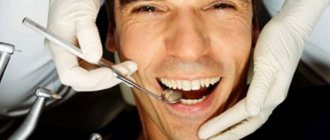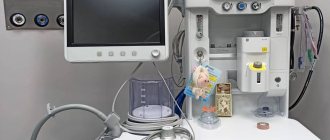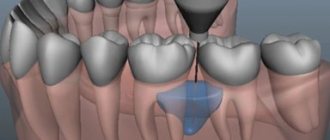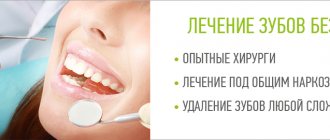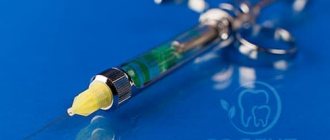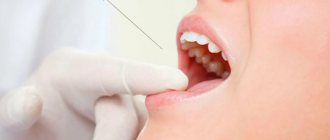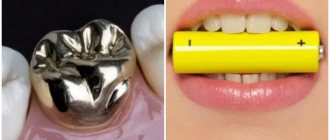Dental practice involves a large number of manipulations, accompanied by pain of varying severity. Fear of pain in the dentist's chair often forces the patient to refuse medical care until the last minute.
The most popular method of administering an anesthetic is infiltration with an average effect of up to 2 hours
Today, high-quality anesthesia is one of the criteria for which patients put forward the highest demands. People want to receive treatment in a comfortable environment, without unnecessary stress. There are several types of painkillers. Depending on the method of administration and the composition of the drug, anesthesia after dental treatment can last from a couple of hours to a day. The doctor chooses an option based on the complexity of the upcoming intervention.
Content:
- Methods used in dental practice
- Medicines that are most often used in the dental office
- What affects the duration of the anesthetic effect?
- What to do to quickly forget about dental intervention
- After what time can you eat?
Most people are afraid to have their teeth treated because they are afraid of pain.
It seems to them that any medical manipulation will cause them serious discomfort. Fortunately, the days of painful dental procedures are far behind us. Today, using highly effective anesthetics, doctors manage to make even the most complex procedures comfortable for the patient and completely painless. Meanwhile, some clients have a question about how long the anesthesia wears off after tooth extraction or pulpitis treatment. They are embarrassed by a long-lasting feeling of numbness. Let's consider this issue in more detail.
Types of pain relief
Dentists, as a rule, provide drug local anesthesia, which involves injecting the drug into the tissue in the treatment area. The effect of the product lasts for a certain time required by the specialist to perform the treatment procedure. After a short period of time, the drug is eliminated from the body, and tissue sensitivity is restored.
Treatment under general anesthesia is rarely performed. It is often used in complex jaw surgery operations.
Local anesthesia
Local anesthesia is almost always performed during dental treatment. It causes less stress to the body, so it is used even for children. A few years ago, only injections of Novocaine and Lidocaine were used. However, today different substances and their forms are used for pain relief.
- Application anesthesia
Anesthesia provides a superficial decrease in sensitivity. A special spray, gel or ointment is applied to the causative area of the oral cavity. A common substance is a solution of Lidocaine, produced in the form of an aerosol. This type of sensitivity reduction is indicated for manipulations with a minor degree of intervention, for example, when removing stone or preparing the dentition for prosthetics.
The concentrated drug penetrates the tissue by 2-3 mm and blocks nerve endings. The effect is noticeable within a few minutes and lasts half an hour to an hour. The anesthetic is not absorbed into the circulatory system, therefore the method is considered the safest. Other disadvantages of topical anesthesia include the insignificant depth of anesthesia and the short duration of its action.
- Infiltration anesthesia
Such anesthesia makes it possible to reduce the sensitivity of one element of the dentition or a small area of periodontal tissue. Such anesthesia is recommended for depulpation or when treating teeth severely damaged by caries.
The drug is injected into the root apex area. The substance does not allow the passage of a pain impulse in the area of the nerve branch. The method is recommended for the treatment of upper teeth, since the bone skeleton of the upper jaw is thinner and allows easy access to the nerves. The disadvantages of the method include the need to use a significant amount of anesthetic if it is necessary to anesthetize a large area. There is also a high risk of soft tissue deformation (swelling) at the injection site, which may interfere with the effective implementation of the procedure.
- Conduction anesthesia
This anesthesia is used to anesthetize several dental elements located in a row “in the neighborhood.” This method of reducing sensitivity is used during tooth extraction, puncture of inflammation, acute periodontitis and when installing a drainage system in a purulent focus. A properly selected anesthetic temporarily reduces the sensitivity of an entire nerve branch. The disadvantage of the technique is the high risk of injury to the nerve and vascular network. Manipulations require specialist skills.
- Intraligament method
When treating children's teeth, an intraligamentous method of pain relief is used. The substance is injected into the periodontal zone, near the alveoli and tooth root. With this method, the mucous membrane does not lose sensitivity, so the risk of the baby biting the mucous membrane and lips is reduced.
- Intraosseous anesthesia
This type of sensitivity reduction is indicated when tooth extraction is necessary. The substance is injected into the gum, reducing the sensitivity of the target tooth and gum area. Pain relief occurs very quickly, but the effect does not last long.
- Trunk anesthesia
With this type of anesthesia, the trigeminal nerve and its branches at the base of the skull are blocked. This radical method is used for extensive operations in dentistry and jaw surgery. The duration of anesthesia is increased due to the vasoconstrictor. Trunk anesthesia affects both jaws. The patient is constantly monitored.
When is pain relief not performed?
Before using this or that drug, the dentist finds out whether the patient has mental illnesses or allergic reactions. Drug pain relief is not used if:
- allergy;
- cardiac ailments;
- diabetes;
Important: Drug pain relief is administered to pregnant women and nursing mothers with extreme caution.
In some cases, when anesthesia is contraindicated, drugs are used in dentistry to relieve the patient of anxiety. Sedatives reduce fear, are not hypnotics, and give good results. They are prescribed by the dentist depending on the need.
What drugs are used in dentistry for pain relief?
Novocaine and Lidocaine have already been mentioned. In modern practice they are used less and less. Experts prefer modern anesthetics: Articaine, Ultracaine, Scandonest, Septonest.
Anesthesia drugs in dentistry are prepared in capsules, which are placed in the body of a syringe with a thin needle.
What complications can arise when using painkillers in dentistry?
Common side effects when using anesthesia include:
- allergic reactions due to individual intolerance to the drug;
- poisoning (when using an overdose);
- nerve injury from a needle (in case of violation of the local anesthesia protocol).
The following manifestations and conditions may also be observed after an injection:
- swelling and hematomas due to damage to the blood branch;
- infection of tissues at the site of drug administration due to the doctor’s violation of the rules of asepsis and antisepsis;
- trismus due to nerve damage;
- biting soft tissues due to loss of sensitivity after administration of the drug.
How to prepare for anesthesia?
It is recommended to refrain from drinking alcohol two to three days before the procedure, as ethyl alcohol reduces the effect of the drugs. If you're nervous about your upcoming dental visit, take a sedative at night. Dental treatment is not carried out against the background of colds.
General anesthesia
Anesthesia is a complete (temporary) loss of sensitivity in a patient, which is accompanied by impaired consciousness of varying degrees. This method of pain relief is rarely used in dentistry.
The indication for general anesthesia is one of the following conditions:
- intolerance to local anesthetic drugs;
- mental conditions and disorders;
- pathological fears of dental procedures.
Before visiting a dentist, if procedures are to be performed under local anesthesia, the patient is required to undergo a medical examination:
- ECG and consultation with a cardiologist;
- laboratory blood tests;
- consultation with a therapist.
Before visiting the dentist's office, you should avoid drinking alcohol. Eating on the eve of the visit and in the morning is contraindicated. General anesthesia is carried out only by an anesthesiologist in the presence of a resuscitator.
Methods used in dental practice
How long it takes for the anesthesia effect to disappear depends directly on the method of anesthesia used. The sensitivity of tissues is restored most quickly when using an application. The doctor applies a special gel to the area of upcoming manipulations, which “freezes” for about fifteen minutes.
If the anesthetic medication was administered using a syringe and needle, the area will remain numb for up to one to three hours. The exact time is determined by the location of the treated area, the dose and type of drug.
Local vs General
There are a number of reasons why general anesthesia may be chosen over local anesthesia.
This choice depends on age, health and personal preference.
The main reasons for choosing general anesthesia are:
- The procedure will likely take a long time.
- There is a possibility of significant blood loss.
- This may affect breathing, for example during breast surgery.
- The procedure will make the patient feel uncomfortable.
- It is difficult for the patient to maintain a forced position during surgery.
The purpose of general anesthesia is to induce:
- pain relief or elimination of the natural response to pain
- amnesia or memory loss
- immobility or elimination of motor reflexes
- dream
- relaxation of skeletal muscles
However, the use of general anesthesia poses a higher risk of complications than local anesthesia. If the surgery is minor, then the patient is offered local anesthesia, especially if he has a condition such as sleep apnea or other risk factors.
Medicines that are most often used in the dental office
If you need to numb a tooth, the doctor may use different drugs. The list of the most popular includes:
- Novocaine. Has a short period of action.
- Lidocaine and products containing articaine. Provides a medium-duration analgesic effect.
- Bupivacaine, Hirocaine, Ropivacaine. They have a long period of action.
The doctor determines which drug to choose taking into account the complexity of the upcoming treatment procedures. It is important that the patient is not allergic to the prescribed anesthetic.
How to treat teeth without pain?
Today, all therapeutic and surgical procedures performed by a dentist with the risk of causing pain to the patient are carried out exclusively after the use of painkillers. Dentists use different types of anesthesia, which means reducing the sensitivity of the injection site to any external influences. The administered medication prevents the “pain impulse” from entering the brain, so the person “feels nothing.” Anesthesia in dentistry is necessary so that the patient avoids unpleasant sensations when a specialist performs treatment. When the patient is not in pain, he can remain at rest for a long time. These are optimal conditions under which the dentist can perform manipulations more efficiently and effectively.
What affects the duration of the anesthetic effect?
The same drug may work differently in different people. For example, for some the analgesic effect disappears in one hour, while for others it lasts two or even three hours. What affects the duration of anesthesia, besides the pharmacological characteristics of the drug itself? There are several fundamental factors:
- The presence of inflammation in the anesthetized area. For example, after the removal of a wisdom tooth that was painful, the rehabilitation period is always delayed. The fact is that the active compounds of anesthetics have an alkaline environment, and in a localized inflammatory focus it is acidic. The combination of the two media causes neutralization of the alkaline composition of the drug. Because of this, the pain relief effect either does not develop at all or disappears very quickly. With advanced inflammation, it is very important to correctly calculate the optimal amount of pain medication so that the patient does not feel acute pain during treatment.
- The inclusion of components in the administered drug that promote spasm of blood vessels. Such substances make the anesthetic more effective and increase the duration of its action.
- Patient's age. It is more difficult for older people to obtain pain relief, and the anesthetic effect lasts longer.
- The presence of diseases of internal organs. Metabolites of dental drugs are eliminated from the body due to the work of the kidneys and liver. If there are diseases of these organs, anesthesia lasts longer.
- Experience and accuracy of the dentist. When giving an injection, the doctor must follow the injection technique and accurately calculate the dose. Any mistake makes the result of using an anesthetic unpredictable.
Why does anesthesia not go away after dental treatment?
Sometimes the effect of the painkiller lasts longer than expected. The patient can try to reduce the effect of the anesthetic at home. To do this, apply a non-hot compress or massage to the site of anesthesia during the day. This will lead to expansion of the capillaries, which will speed up the removal of active substances from the anesthetized area, and the anesthesia will wear off faster.
In this case, you need to contact your doctor for advice. In addition, these measures are permissible if a filling is placed, but in no case after tooth extraction.
To ensure that the drug does not last longer than necessary, the patient’s liver should not be overloaded, since it is the liver that is responsible for removing the drug from the body. You should also not drink alcoholic beverages immediately after visiting the dentist.
Sometimes anesthesia may not go away due to complications. The main reason for the long-term effects of anesthesia is damage to the nerves of those organs where the zone of anesthesia was located. This may require the help of not only a dentist, but also a neurologist. This occurs both when the pain medication is administered incorrectly, and as a result of the treatment itself.
The prolonged effect of anesthesia should not create panic. The normal duration of anesthesia after injection of an anesthetic into the upper jaw is 2-3 hours, for the lower jaw - 4-5 hours.
If, during these standard dental procedures in the oral cavity, the tooth was anesthetized for a longer period of time, headaches, chills, or general malaise appeared, it is necessary to seek qualified help in a timely manner. The specialist will determine the cause and take measures to ensure that the anesthesia wears off in accordance with the norms.
Sometimes physical therapy may be necessary to eliminate negative symptoms. But cases where anesthesia takes too long to wear off are rare. Also, prolonged exposure to anesthesia is a result of the patient's hypersensitive reaction to the drug.
What to do to quickly forget about dental intervention
Very often, upon returning home, the patient continues to feel numbness in part of the jaw. This condition can cause discomfort and even mild aching pain. In order for tissue sensitivity to be restored as quickly as possible, the following rules should be followed:
- On the eve of planned dental procedures, avoid drinking alcohol , fatty and heavy foods. If a specialist recommends taking any medications, it is important to follow his prescription.
- In the case of treating caries , removing tartar, grinding down the top layer of enamel under a crown, it is permissible to massage the gums. You can also drink warm tea or heated water. These simple methods will increase local blood circulation and create conditions for the speedy release of anesthesia. But, if anesthesia was administered before tooth extraction, there should be no talk of any self-massage - touching the hole with your hands is strictly prohibited. Otherwise, you can damage the blood clot that protects the wound from the penetration of bacteria and germs. This will lead to severe inflammation and bleeding.
Don't be alarmed if the anesthetic continues to work for up to six hours. The situation will normalize on its own. If the numbness does not go away longer, this is a reason to consult a dentist again.
What can I do to make the anesthesia wear off faster?
If the patient does not want the anesthesia to wear off for a long time and cause unnecessary discomfort, you can follow simple tips:
- When planning a trip to the dentist, you should exclude fatty foods and alcohol from your diet. This will help relieve the liver and other glands that produce secretions to speed up metabolism. Thus, the anesthetic will be removed from the body faster, and the frozen area will recover from anesthesia more quickly. It is worth limiting the intake of medications except for those that are necessarily prescribed by the doctor and the refusal of which can lead to negative consequences.
- After minor dental procedures, significant volumes of liquid and massage of the freezing zone will help relieve anesthesia.
- In case of complex operations, on the contrary, it is necessary to exclude impact on the place where the intervention took place. Eating food and liquids is possible no earlier than four to five hours later.
If the numbing, pain-relieving effect does not subside for quite some time after visiting the dental office, this may indicate that a nerve has been affected. In this case, you should consult a doctor for additional help and advice to avoid negative consequences.
Before going to an appointment, each patient at a dental clinic must be sure that there are no allergic reactions to anesthesia. Otherwise, before using anesthesia, the doctor must conduct testing by administering a small dose of the drug. This will allow you to get rid of possible problems and side effects after visiting the dentist.
Category: Tooth extraction Published by Mister stomatolog
What is complex wisdom tooth extraction?
Tooth extraction is called complex if the tooth has several roots, and the operation will require an incision into the soft tissue of the gums and, possibly, the periosteum. Another difference from classic removal is the need to use additional tools (except for forceps and an elevator). The difficulty of performing surgical intervention is due to the difficulty of accessing the extreme elements of the dentition, the root features of the “eights” and the specifics of the clinical case (they are often dystopic or impacted).
Important: you cannot postpone the removal of the defective “eight”. This can lead to suppuration and, as a consequence, to the formation of an abscess and the development of sepsis.
Sedation
Fear. This is the feeling that most people have when they think about visiting the dentist's office. Under a feeling of fear, movements become constrained, and especially impressionable people may even lose consciousness during or immediately before the procedure.
For emotional and physical relaxation, sedation is used in dentistry. Through a special mask, the patient inhales an oxygen-nitrogen mixture. Thanks to this, a feeling of calm appears. This procedure is in demand in pediatric dentistry, since it is usually difficult to calm a small child before the procedure.
If the patient has respiratory diseases or sensitivity to the components of the gas mixture, sedation is given intravenously. But this method is used extremely rarely.
Sedation in no way replaces anesthesia. It is used as an adjunct to calm and relax the patient. At the same time, he remains conscious throughout the session, and the effect of the gas wears off as soon as the mask is removed.
However, it is worth noting that despite all the seemingly positive effects of sedation, it is better to do without it. A clear mind and fresh consciousness allow you to quickly respond if necessary if something goes wrong.
Sedation or anesthesia?
Sedation and anesthesia are two different things. Sedation does not disconnect consciousness from the outside world. It is more like a state of light dozing. However, it is also a medical exposure to the body that should be avoided. It is quite possible to manage only with anesthesia. If you are very nervous, you can do a breathing practice that will help you calm down.
Anesthesia is a more serious manipulation. It has a number of side effects:
- dizziness, nausea;
- severe thirst after the end of the effect, but you can’t drink;
- weakness;
- chills or, conversely, high temperature.
In addition, after recovering from anesthesia, you need to remain in bed for some time and limit physical and thermal stress.
The worst thing that can happen during anesthesia is cardiac arrest. This happens with incorrect diagnosis and incorrect selection of the dosage of the drug. However, it is best to avoid additional procedures beyond local anesthesia.

